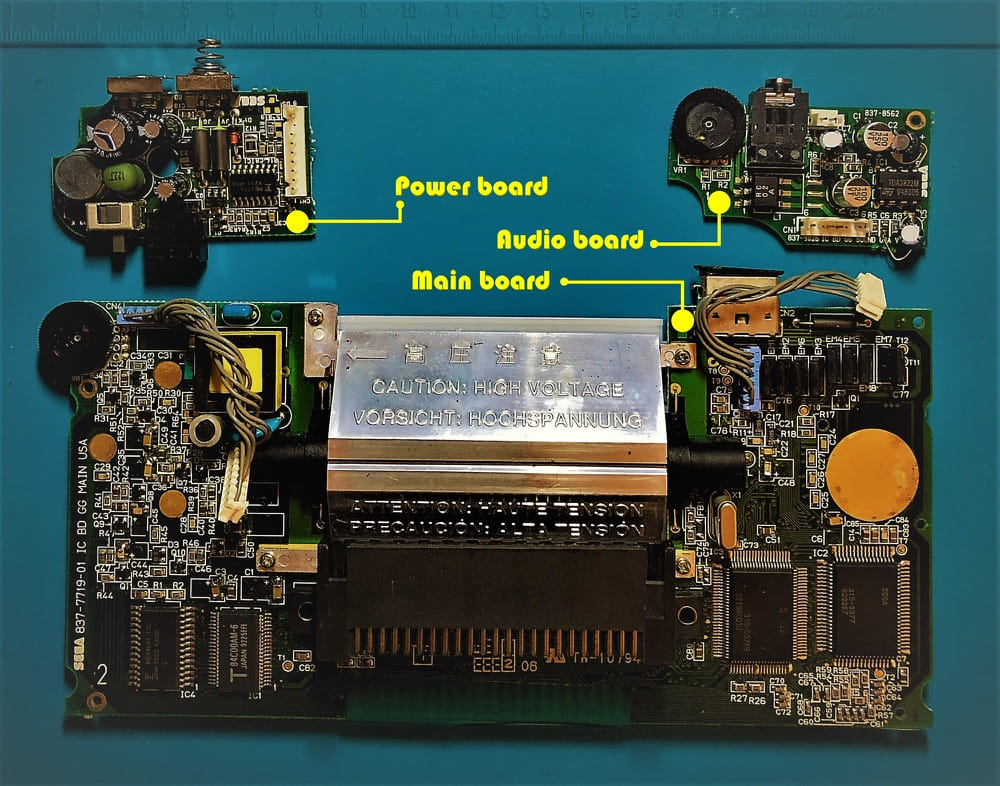When it comes to handheld gaming consoles, the Sega Game Gear holds a special place in gaming history. Released in 1990 by Sega as a colorful alternative to Nintendo’s Game Boy, the Game Gear pushed the boundaries of portable gaming with its vibrant display and impressive hardware. In this blog post, we’ll take a closer look at the hardware components that made the Game Gear a standout handheld console of its time.
- Processor: At the heart of the Game Gear beats an 8-bit Zilog Z80 central processing unit (CPU) running at a clock speed of 3.58 MHz. This powerful CPU, also used in the Sega Master System, ensured smooth gameplay and efficient performance for the handheld console.
- Display: One of the standout features of the Game Gear was its backlit, color, and non-backlit TFT LCD screen. With a resolution of 160x144 pixels, the 3.2-inch landscape-oriented screen brought games to life with vibrant colors and enhanced graphical details. The Game Gear’s display offered an immersive visual experience that surpassed the monochrome screens of its competitors.
- Sound: The Game Gear delivered an enjoyable audio experience through its built-in mono speaker. Additionally, the console supported stereo sound through the use of headphones or external speakers. This allowed players to fully immerse themselves in the sound effects, music, and dialogue of their favorite games.
- Controls: The Game Gear boasted a well-designed control layout to enhance the gaming experience. It featured a responsive directional pad (D-pad) for precise movement control and eight buttons. The two action buttons (labeled 1 and 2), Start and Pause buttons, along with the volume control buttons, provided intuitive and convenient gameplay control for players.
- Memory: To support game data and processing, the Game Gear was equipped with 8 KB of RAM and 16 KB of video RAM (VRAM). Additionally, the console utilized ROM cartridges for game storage and playback. These cartridges came in various capacities, ranging from 512 KB to 2 MB, allowing for a wide range of games with diverse content.
- Power: With great gaming power came the need for sufficient energy. The Game Gear required six AA batteries for operation, inserted into the back of the console. The battery life offered around 3-5 hours of gameplay, allowing players to enjoy their favorite games on the go. Alternatively, players could power the Game Gear using an external AC adapter for extended gaming sessions.
- Connectivity: The Game Gear offered connectivity options to enhance the gaming experience. It included a port for headphones or external speakers, enabling players to enjoy high-quality audio privately or share their gaming adventures with friends. Additionally, the console featured a port for link cable connections, allowing multiple Game Gear consoles to be linked for exciting multiplayer gaming sessions. Some later models even featured an AV output port, enabling users to connect the console to a television for a larger viewing experience.
Technical specifications
These are the complete set of technical speciifications:
- Main processor: Zilog Z80 (8-bit)
- Processor speed: 3.58 MHz (same as NTSC dot clock)
- Resolution: 160 x 146 pixels
- Colors available: 4,096
- Colors on screen: 32
- Maximum sprites: 64
- Sprite size: 8x8 or 8x16
- Screen size: 3.2 inches (81 mm)
- Audio: 3 square wave generators, 1 noise generator, the system has a mono speaker, but stereo sound can be had via headphone input.
- RAM: 24 KB
- Power:
- internal: 6 AA batteries
- external: 9V DC, 300mA, 3W
- Physical:
- Dimensions: 210 x 113 x 38 mm
- Weight: 400g
Conclusion
The Sega Game Gear remains a beloved handheld console that brought color and excitement to portable gaming. Its impressive hardware, including the powerful Z80 CPU, the vibrant color display, and the intuitive controls, made it a compelling choice for gamers in the early ’90s. Despite facing tough competition from the Game Boy, the Game Gear carved out its own place in gaming history, providing an unforgettable gaming experience to millions of players worldwide.
So, let’s remember the Sega Game Gear as a pioneering handheld console that pushed the boundaries of portable gaming, delivering vivid colors, captivating sound, and hours of entertainment in the palm of your hand!
Don't forget to visit our Etsy store
